Related Posts
- Buy Tickets for The Constitutional Walking Tour of Philadelphia – See 20+ Sites on a Primary Overview of Independence Park, including the Liberty Bell and Independence Hall
- Antietam National Battlefield
- Thomas Jefferson - One of America's Founding Fathers
Guest Blogger: Andrew Terranova, Concierge, Sofitel Philadelphia
Charlottesville, Virginia

I stayed at the hip and comfortable Omni Charlottesville, which gave us a great rate during COVID-19 times. The hotel is centrally located in the downtown and the back-door spills open to reveal a charming and hopping pedestrian mall down Main Street. There are lively cafes to people watch, bars to hear live jazz and plenty of shopping. While everyone was safely socially distancing, the advantage of sitting outdoors leisurely is still happily observed. There are even hand sanitizer stations all over the town for people to have a sense of health safety.
Charlottesville is as proud of its favorite son, Thomas Jefferson, as we Philadelphians are proud of Benjamin Franklin. I took a Lyft from the Omni, a 10-minute drive to Monticello. I mentioned to the driver that I’m a huge Thomas Jefferson fan and that I was looking forward to the experience, and he filled my short ride with his favorite stories about Monticello. For instance, I learned from my driver that Jefferson’s beloved University of Virginia is just-so placed that on a clear day he could watch the school he founded from his hilltop home. Jefferson is clearly a superstar here.
I was dropped off at the Visitor’s Center at the midpoint of the mountain. You can park further down at the base of the mountain and hike up a way if you want, but, I decided against that option. The Visitor Center is fairly new, and it has a theater to show you a movie about Jefferson’s life at his home, but it was closed due to Covid-19. There is, however, an above average gift shop which I will tell you more about later.
Monticello – The House
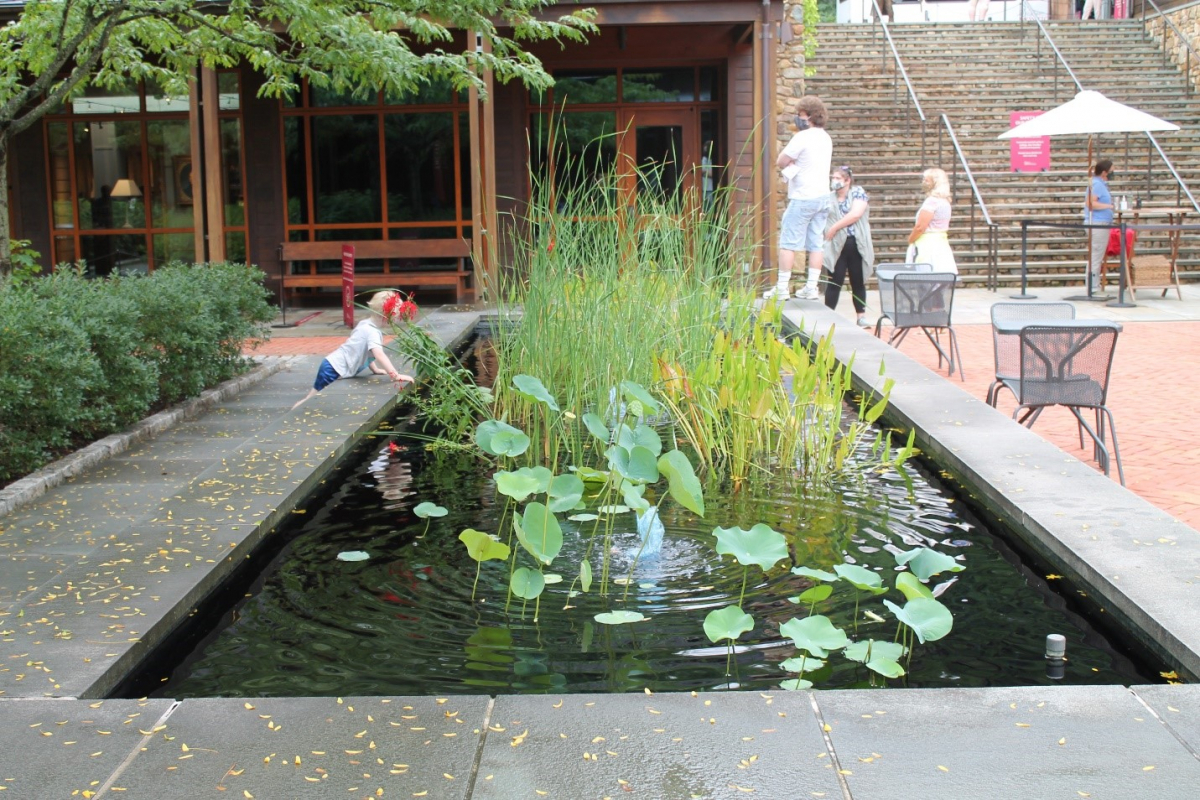
"Architecture is my delight, and putting up, and pulling down, one of my favorite amusements."
– Thomas Jefferson
From the Visitor Center, you’ll catch a swift moments-long shuttle to the top of the hill where you’re greeted by a house that looks vaguely like the back of a nickel. Since they could only let in a handful of people at a time into the house, the guides begin telling the story of the foundation of the structure before going in. Once they let you in, there is no flash photography, although you’re welcome to take pictures. My heart fluttered when I finally stepped through the same threshold that Jefferson had stepped across thousands of times. You can learn more detailed information about Thomas Jefferson’s life and career in a previous blog right here.
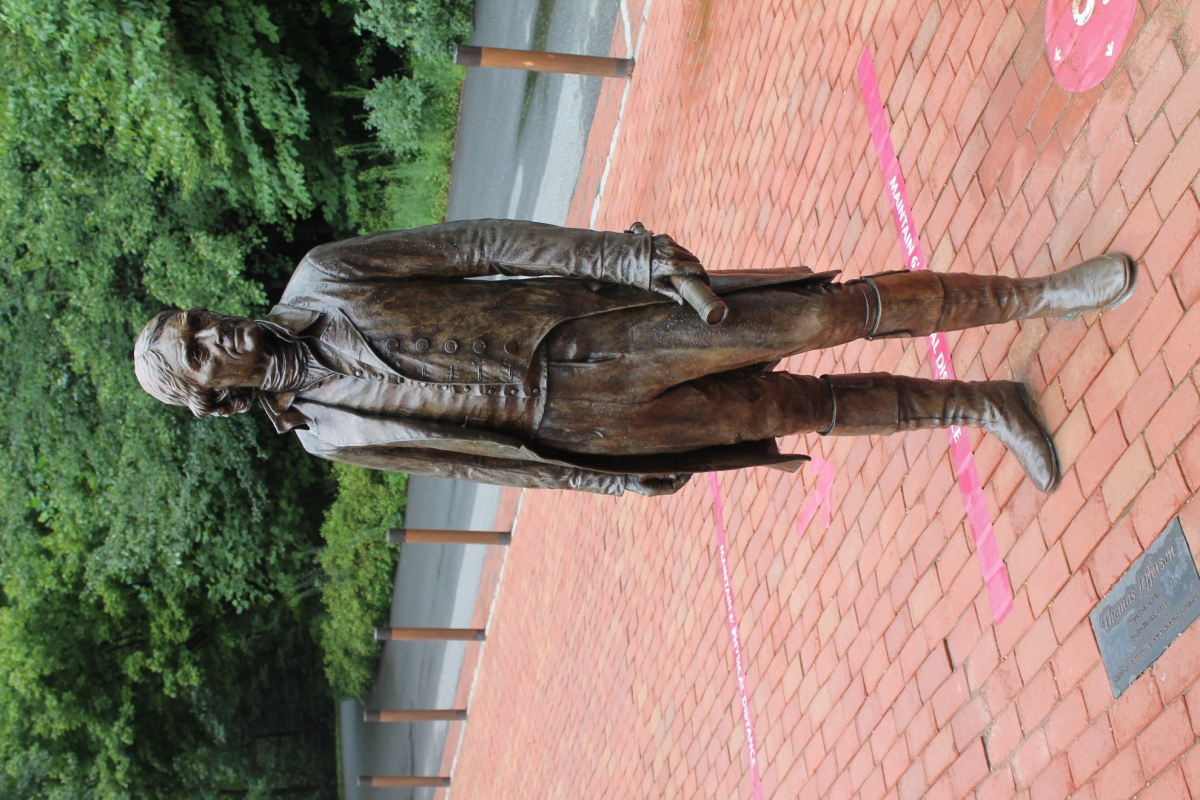
Thomas Jefferson was born in Shadwell, Virginia on April 13, 1743. Shadwell is just a few miles from Charlottesville. At age 16, he entered William and Mary College in Williamsburg, and he studied very advanced subjects for a teenager. He also practiced his violin and became very adept at making beautiful music. When his father, Peter, died in 1757, he inherited the 5,000 acres that would become his plantation. He took full custody of his inheritance at the age of 21.
In 1760, the mountaintop where his home would be located was leveled. In 1768, he began building his home, Monticello (which means “little mountain” in Italian). Construction was started with local masons, skilled carpenters and his slaves. Over his lifetime, Jefferson owned approximately 600 slaves.
The small east pavilion known as “the honeymoon cabin” was first constructed. The main house was based upon a Palladian formula of a two-story central hub, on story wings and a basement built into the hillside and bookended with two small pavilions.
From 1789 to 1793, Jefferson served as Minister to France, and he lived in Paris, where he admired the Hotel de Salm and was inspired by French architecture. Once he returned home, Jefferson never stopped working on Monticello. Although the house was "completed" in 1809, he made alterations until his death on July 4, 1826. There is a flaw in the building, which is because the second-floor windows interrupt the impression of a single-story building that was Jefferson’s desire to create. As one senses in visiting Monticello, the house was an evolutionary building for a revolutionary man. Architecturally it more resembles a villa, not a classic 18th Century plantation.
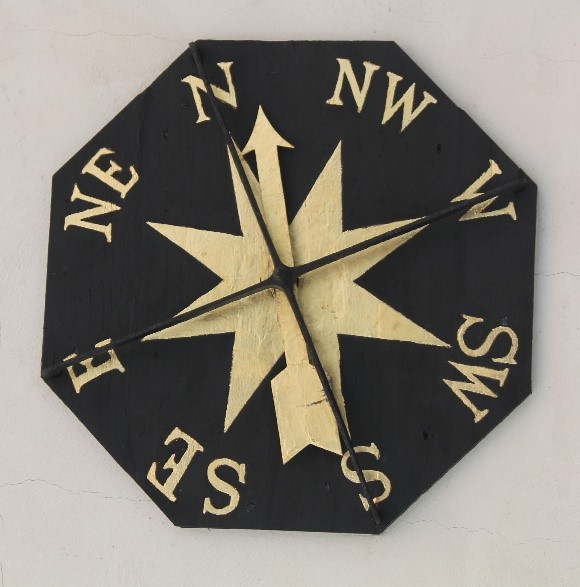
When you walk under the building’s portico, look up and you’ll see a working weathervane that tells direction of the wind. Jefferson was fascinated with meteorology and it’s the first clue you’ll be entering the home of a man with a scientific mind.
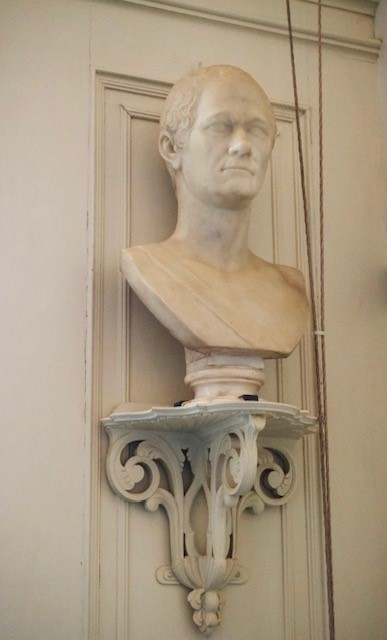
Guests would enter the Hall when visiting Monticello. There’s a lot of cool things to keep an eye out for, including a framed engraving of John Trumball’s signing of The Declaration of Independence and a bust of Alexander Hamilton. Wait, what? He’s got a bust of his arch nemesis, with whom he was “opposed in death as in life”? The old adage “keep your enemies closer” comes to mind.
“I can not live without books…”
-Thomas Jefferson
You’ll turn left out of the Hall to get to his famous library. Most of his collection went to the Library of Congress in 1815.
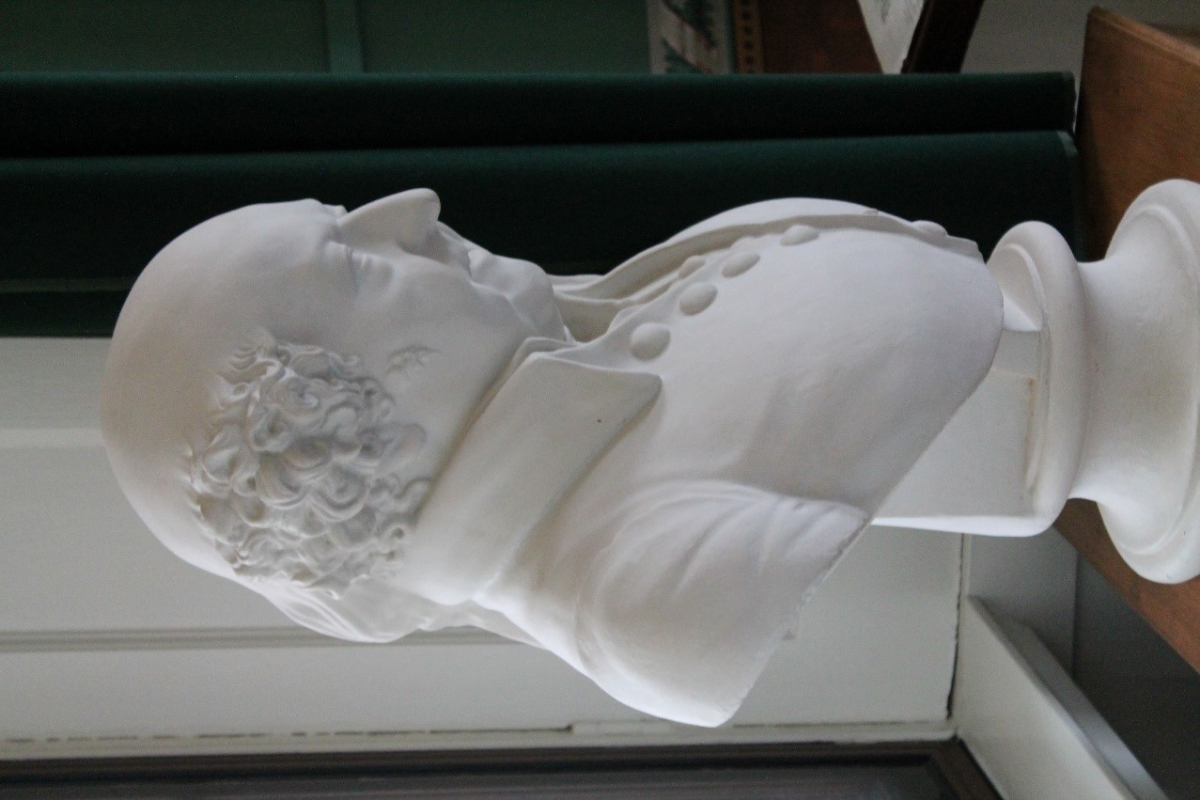
When you get into the Cabinet, you can feel the quaintness of a small writing nook. This is where he took up many of his remarkable correspondence while spending wistful hours surveying his plantation from the scenic windows. You’ll see a bust of John Adams to your left. I inquired about the bust of Adams, if it was actually Jefferson’s, and I got this e-mail response from the stewards at Monticello:
“The Adams bust exhibited in the Cabinet is a copy after the 1818 original made by J.B. Binon. Binon made six plaster copies of the bust, including the ones given to John Adams, John Quincey Adams, the Boston Athenaeum, and Thomas Jefferson. Jefferson received his Adams bust from Benjamin Gould in 1825, which was quite late in his life. While we know Jefferson displayed the bust in his Library or Cabinet, we do not know exactly where it sat. Unfortunately, Jefferson’s copy is currently unlocated, although we would love to locate it one day!”
Keep an eye out for the original Adams bust if you ever see it antiquing. I found it interesting and endearing to have a bust of Adams in Jefferson's writing room, since he did so much letter writing to John Adams and Mrs. Adams from 1812 until John Adams and Thomas Jefferson both died on the same day, July 4th, 1826 – the 50th anniversary of our nation’s independence. The two had a brutal falling out during the election of 1800 when Jefferson beat him for the Presidency. It took almost 12 years for them to resume speaking. I believe their “bromance” to be one of the most heartfelt (and volatile) in American history.
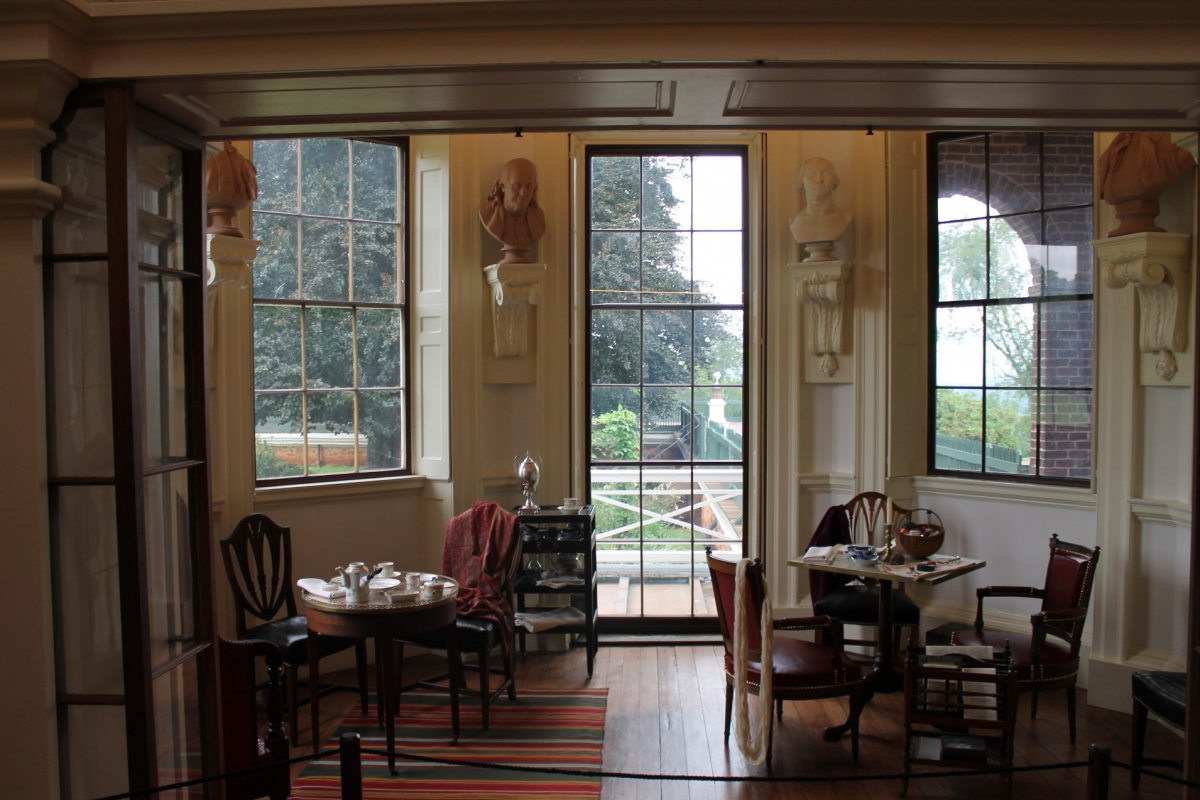
I found the Tea Room another charming room on the first floor. Jefferson referred to the room as his “most honorable suite” because of his adorations with American heroes. As you can see, Ben Franklin and George Washington watch over the room as busts.
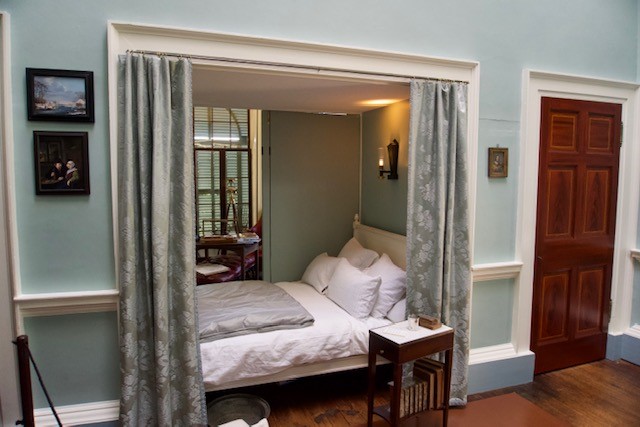
The first-floor bed chamber is where an intensely private man had his own piece of solitude and away from the nuisance of noises from the never-ending construction. Every morning he rose from the Alcove bed and either stepped on one side to get into his cabinet or the other side to get into his bedroom. This is the room where he passed away, in the Alcove bed.
Unfortunately, the second and third floors were closed to visitors. As the staircase is original, it cannot risk being constantly disinfected for Covid.
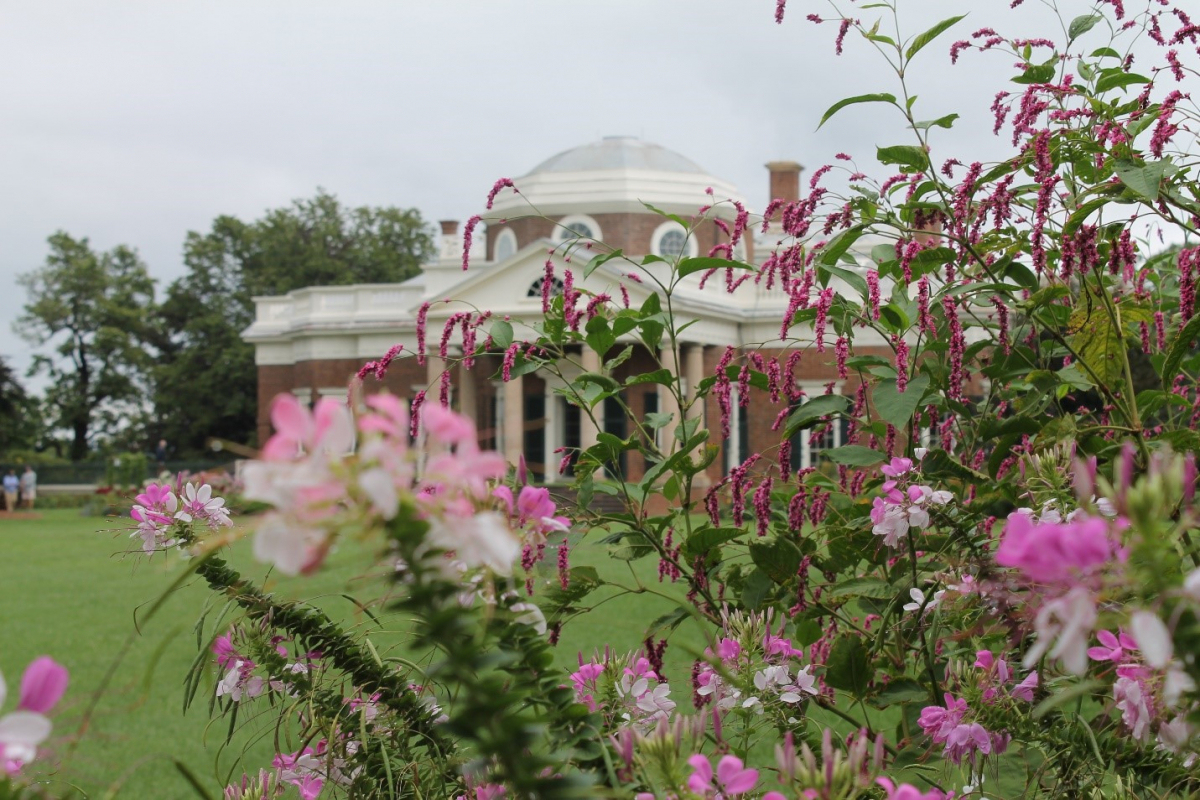
The guides in the house were very chatty and attentive. They were eager to answer many of my questions. For instance, they told me for all the extravagances you’ll see in Monticello, Jefferson died deeply in debt, and the house was purchased by Commodore Uriah Phillips Levy and it passed through several hands before the Thomas Jefferson Memorial Foundation acquired it in 1923.
As you exit the building, which I found surprisingly small, you can turn right to walk down an outdoor terrace leading to the basement entrance. The basement is full of neat stuff, including the kitchen, wine cellar and beer room.
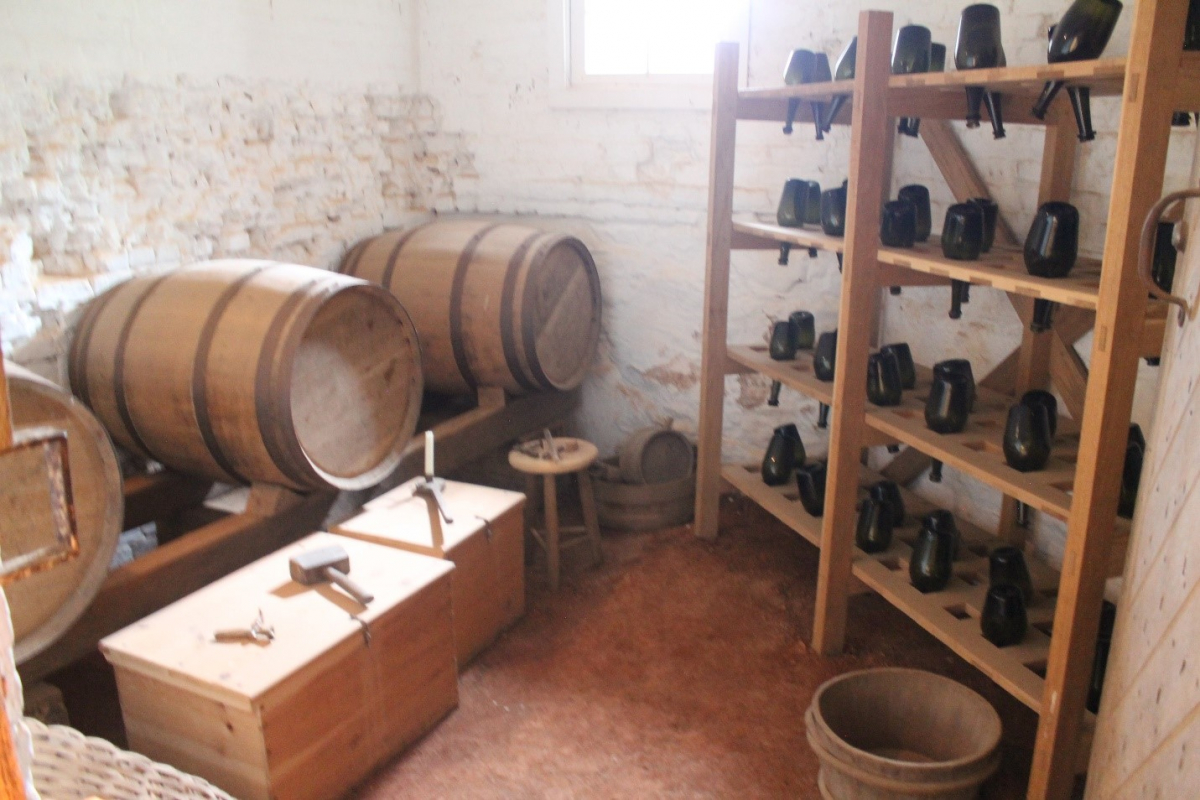
To say Jefferson enjoyed his wine is an understatement. He nearly went broke purchasing wines from France and all over Europe. He stored his wine in the basement and used bottle-sized dumbwaiters that rose through the cellar ceiling into both sides of the mantelpiece in the dining room above. This allowed
minimal intrusion as the libations flowed at Jefferson’s soirees. Wine was usually served after dinner while beer and cider were served during meals.
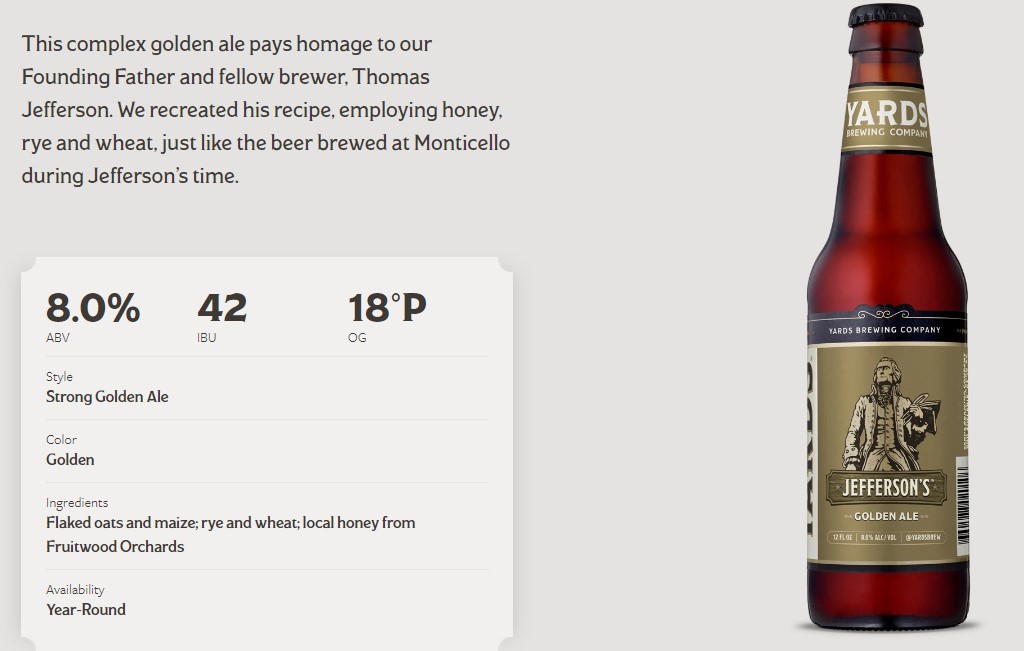
There is no record of Jefferson brewing his own beer until 1813. That year, Captain Joseph Miller, a British citizen who became trapped in the country during the War of 1812 and a very adept brewmaster, was hired by Jefferson to teach the cook Peter Hemings how to malt the grains and brew the beer. Hemings became quite good at his brewing and made 100 gallons of ale twice a year in the spring and fall.
You can catch a taste of history here in Philadelphia at the City Tavern or at Yard’s Brewery, where they recreate Jefferson’s own Golden Ale recipe. Although the beer brewed by Jefferson had a very low alcohol content, the Yard’s version is 8%. So drink up, you’re drinking history – although drink responsibly!
Monticello – The Grounds
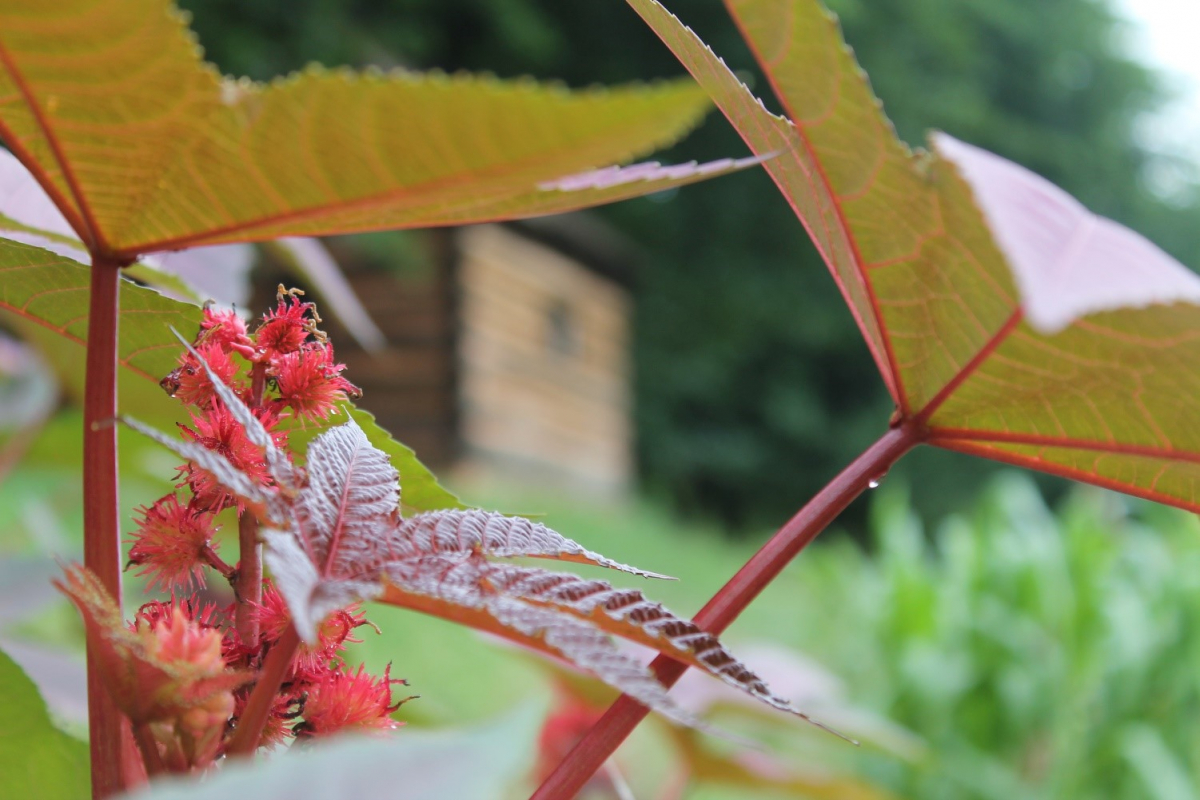
Outside the basement is a wonderful world of lush greenery to explore. The gardens seem to stretch for miles into a painted Virginia sky. A quaint feature to notice is Jefferson’s fish pond, where he always had fresh caught fish available for the night’s menu.
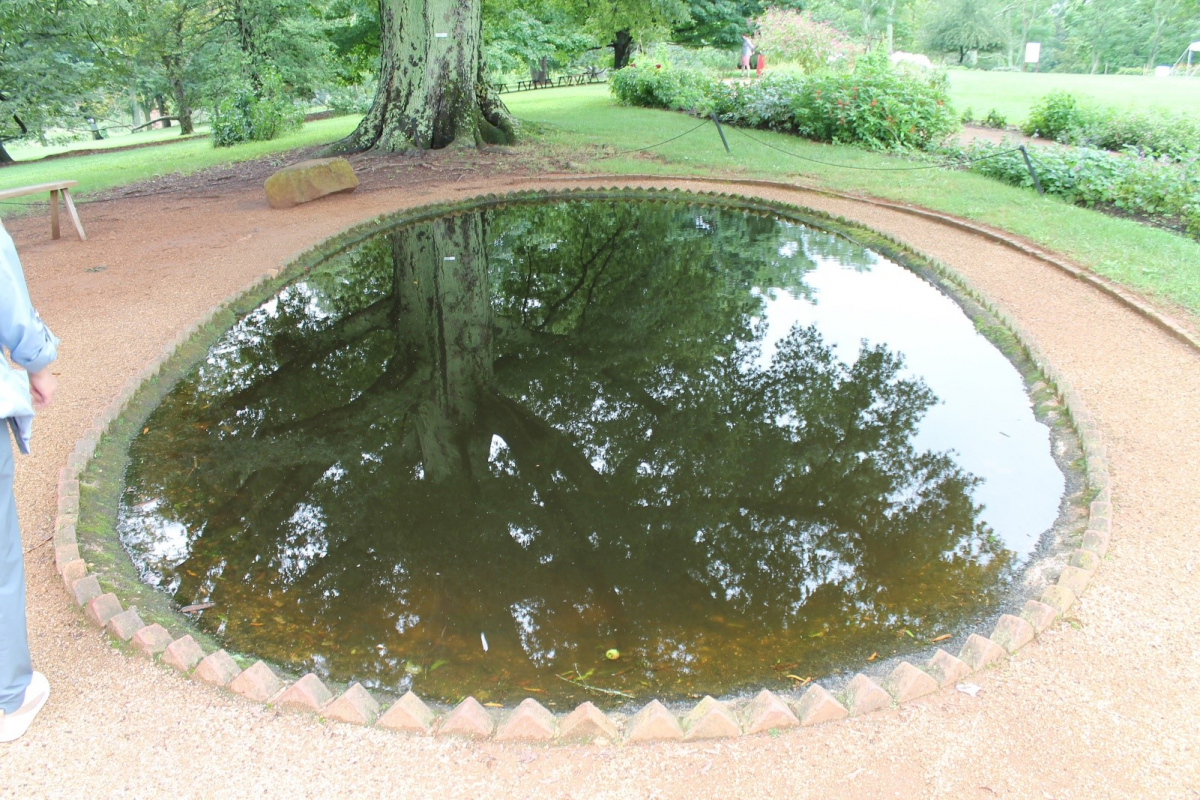
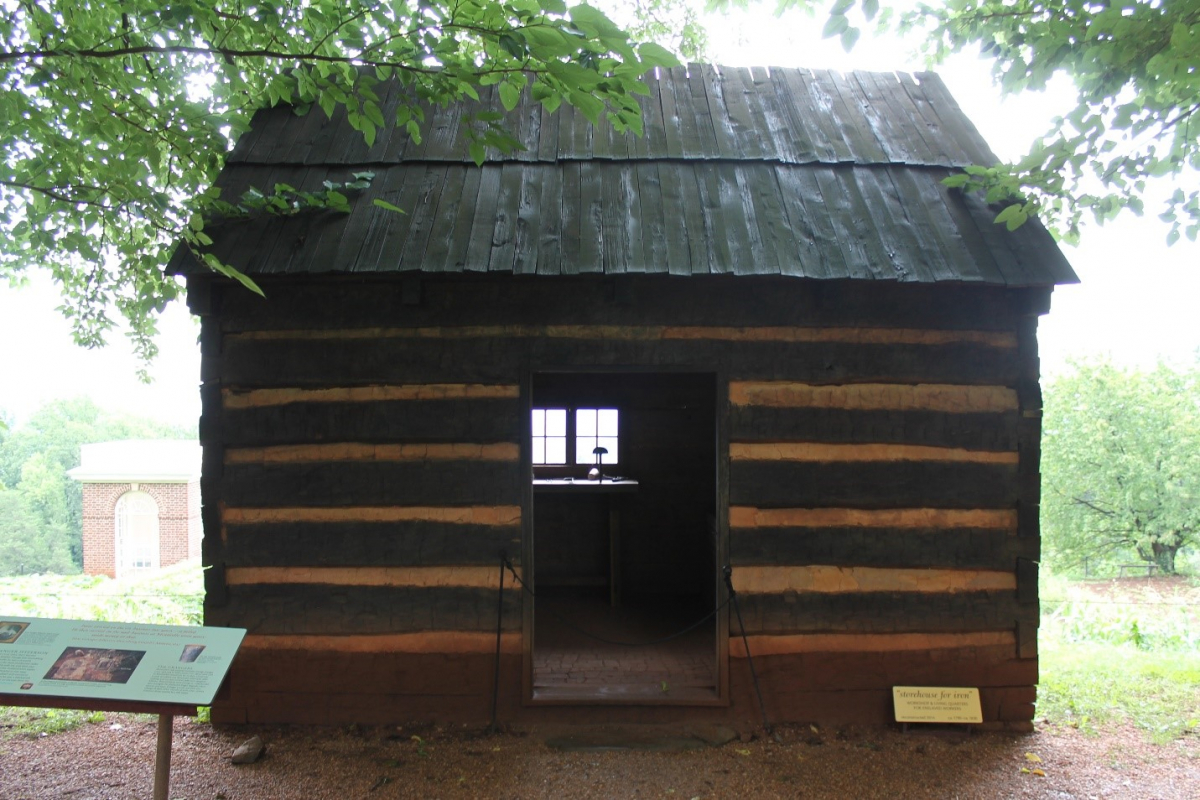
According to "The Hemingses of Monticello: An American Story" by Annette Gordon-Reed,
"It seems especially appropriate to tell one part of the story of slavery through life at a place that holds such symbolic importance for many Americans —Monticello. For it is there that we can find the absolute best, and the absolute worst, that we have been as Americans. We should not get too far into the twenty-first century without looking back at the Hemingses and their time to remember and learn.”
Turning to Mulberry Row, the home of Jefferson’s mistress and slave, Sally Hemings. She is without a doubt one of the most well-known, yet wholly unknown figures in American slave history. Very little of the truth is known about her and the affair with Jefferson. Like many slave women before her, she bore children to her master while not having the freedom to say “no.” Mixed race children were commonplace in Monticello as they were the across the USA at the time. Everything we learn about Sally opens up a new mystery.
For example, Sally Hemings was born in about 1773 to Betty Hemings (1735–1807), a woman born into slavery. Sally's father was their master John Wayles (1715–1773). In 1787, a 14-year-old Sally took the perilous trek across the ocean from Virginia to London. She met with John and Abigail Adams and stayed with them in London for a few weeks in the summer before being transferred to her master in Paris, who was serving as envoy to France. France outlawed slavery in 1789 after the Revolution, and Sally was paid by Jefferson for her services during her 26 months in the country. To paraphrase a Joni Mitchell song, she was a free woman in Paris. Well, kind of; she was still the property of Jefferson and it’s believed his affair with Sally began in the City of Light. In her son, Madison’s memoir, he states that Sally became pregnant with her first child, Harriet, at 16 in Paris. Sally and her older brother, James, also there, could have petitioned for their complete freedom, but her strong family ties brought her back to Monticello – under one condition: that her children would be freed when they reached 21 years of age.
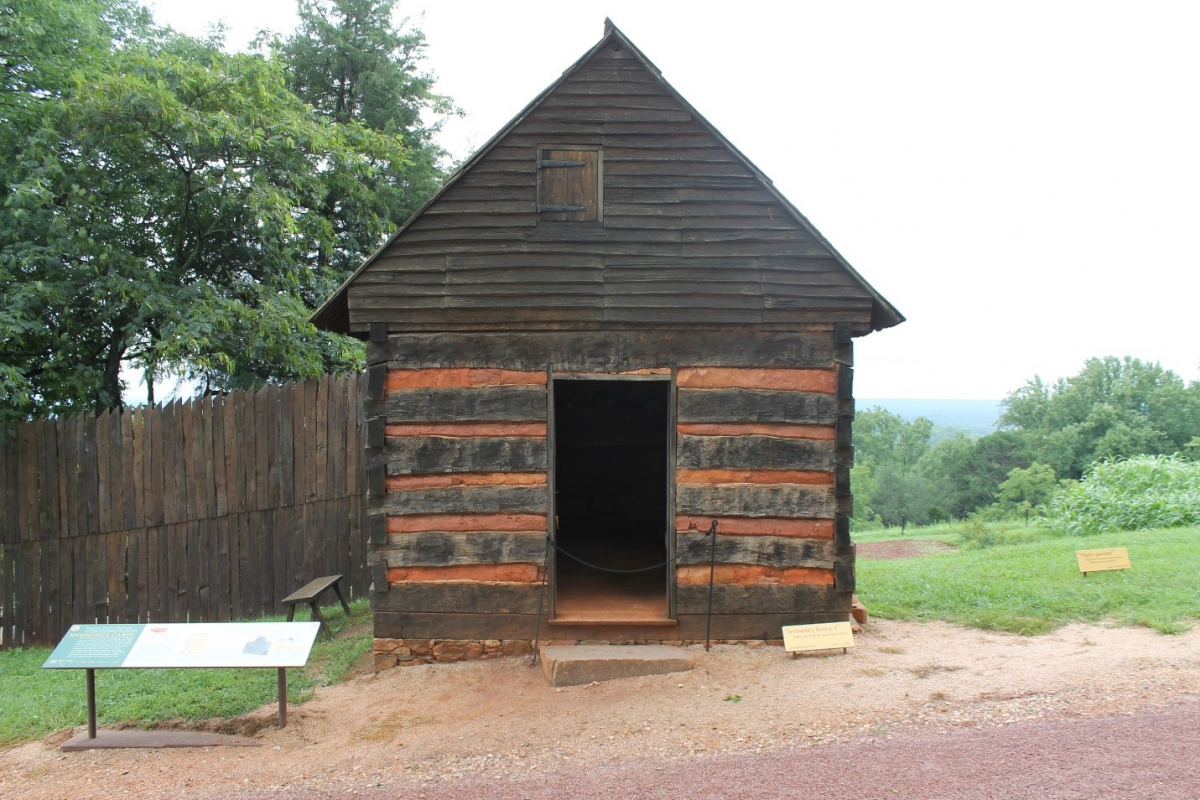
In 1789, teenager Sally returned to Monticello with Jefferson, who was 46 at the time. According to records, Sally’s daughter Harriet died incredibly young, but she bore six children total: Harriet (I), Beverly, Harriet (II), Madison, Eston and one who died in infancy before being named. Jefferson recorded the births in his farm book but went against custom by suspiciously not mentioning the fathers’ names. He eventually freed all of Hemings’ children when they became young adults.
After Jefferson's death, Hemings was "given her time" by his daughter in an informal freedom. She lived her last nine years freely with her two younger sons in Charlottesville. She saw a grandchild born in the house her sons owned. (source: "Bringing Children Out of Egypt", Plantation and Slavery, Monticello. Retrieved January 9, 2012)
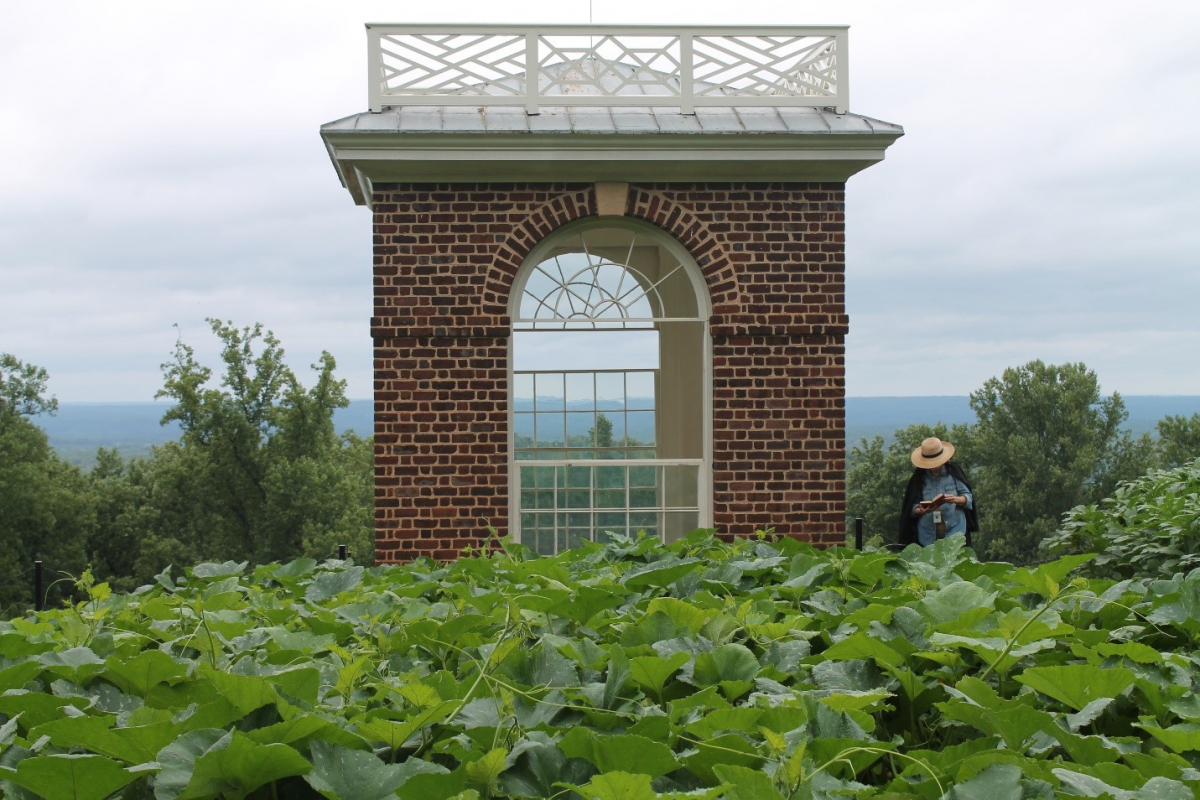
Many of the slave quarters are found on the South Wing of Monticello, along with the narrow, endless strips of gardens. He grew nearly 200 types of fruits and over 300 types of vegetables as well as medicinal plants and decorative botanicals. Talk about being a self-sufficient household, Jefferson never had to go to the local Wegman’s (and yes, there is a Wegman’s in Charlottesville). It can only remind you in a distressing way that slave labor built not just the house, but also tended the garden terrace’s 1,100 feet of hearty greenery.
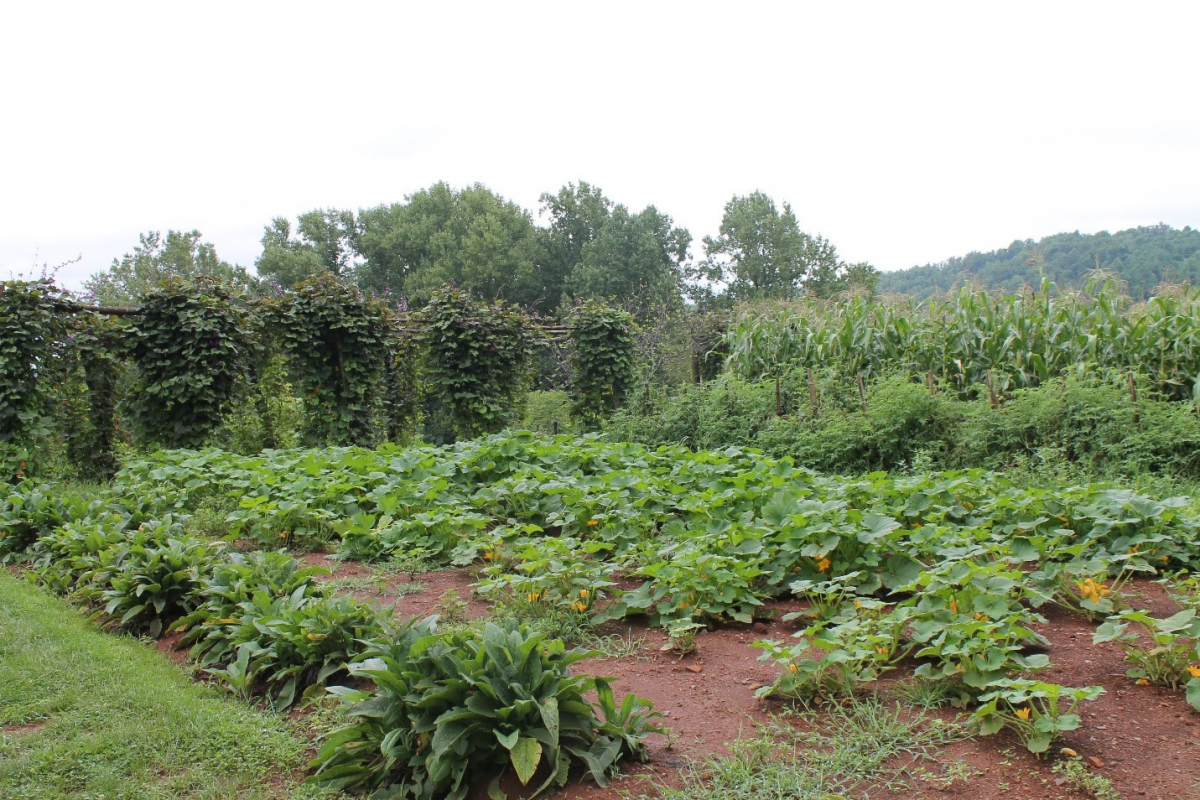
Here’s a tip, stop by the gift shop after your visit and pick up a plant from their greenhouse. All plants sold at the gift shop are from the garden and come with a description of the plant’s purpose and how Jefferson used it. Heirloom seeds from the garden are also available.
Monticello - Thomas Jefferson's Grave
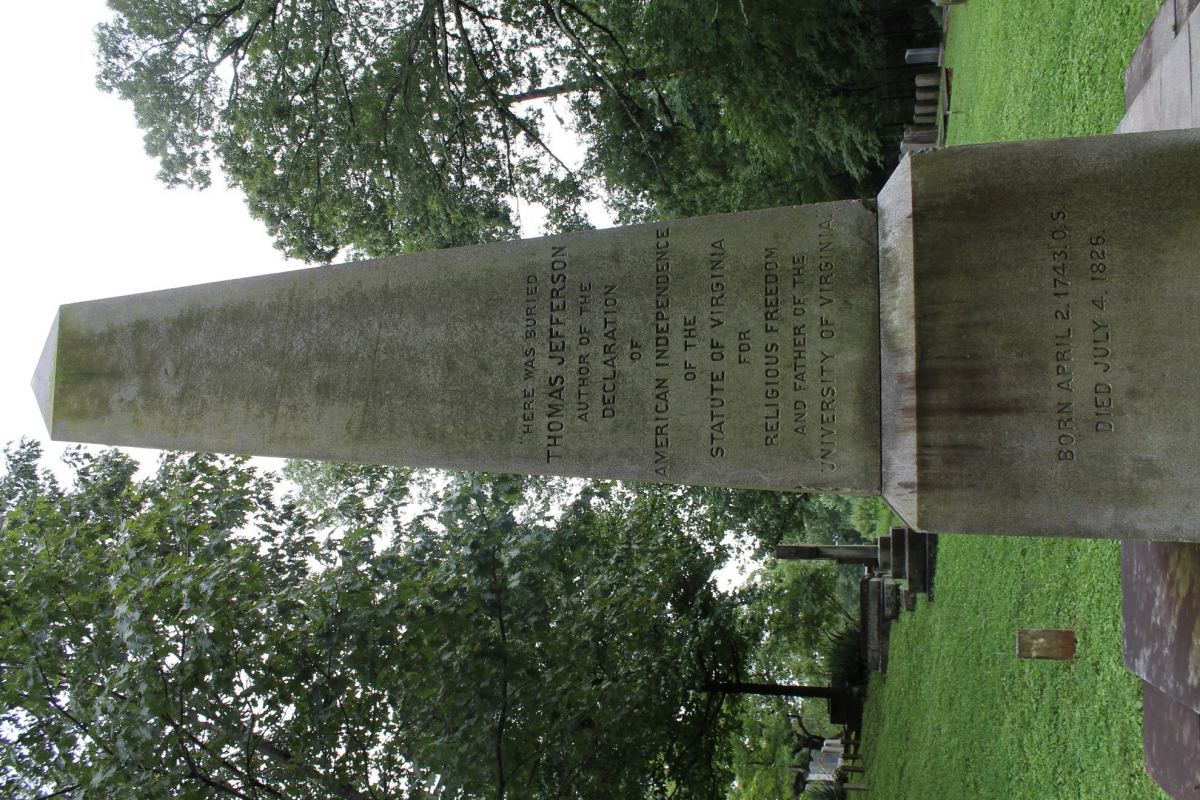
As you make your way to the end of the long, yearning garden, keep walking west to the tip of the yard and go down a small hill to find Thomas Jefferson’s final resting place.
Before he died, Jefferson laid out the explicit directions for how his grave would look. He wanted an obelisk, which he sketched the size and shape of, and dictated his epitaph.
"... on the faces of the Obelisk the following inscription, & not a word more:
‘Here was buried Thomas Jefferson Author of The Declaration of American Independence of the Statute of Virginia for religious freedom & Father of the University of Virginia’
because by these as testimonials that I have lived, I wish most to be remembered."
Why not a word more? Well, look and see what key word is missing from his grave. Certainly, a few things are missing, including first Secretary of State and the Louisiana Purchase, but most importantly – President! His rationalization was that other people will fill the role of President. He was just one of many. But only he wrote the Declaration of Independence, the Statute of Virginia for Religious Freedom and was founder of UVA.
The obelisk you see is from 1833. Immediately after Jefferson’s death, souvenir hunters started chipping away at the original stone. The original obelisk from 1826 is now located at University of Missouri. I had myself a little emotional moment at his grave, wondering how proud he’d be of America today. Perhaps he’d quote himself by saying “I predict future happiness for Americans, if they can prevent the government from wasting the labors of the people under the pretense of taking care of them.” I imagine after begrudgingly discussing politics from his day (most all of our Founding Fathers disagreed on tons of things) compared to politics today (most of our politicians disagree on tons of things), he’d hold his head up in the air, watch a plane travel across the ether on its way to Charlottesville airport, and marvel at today’s miraculous technology.
Monticello – The Gift Shop
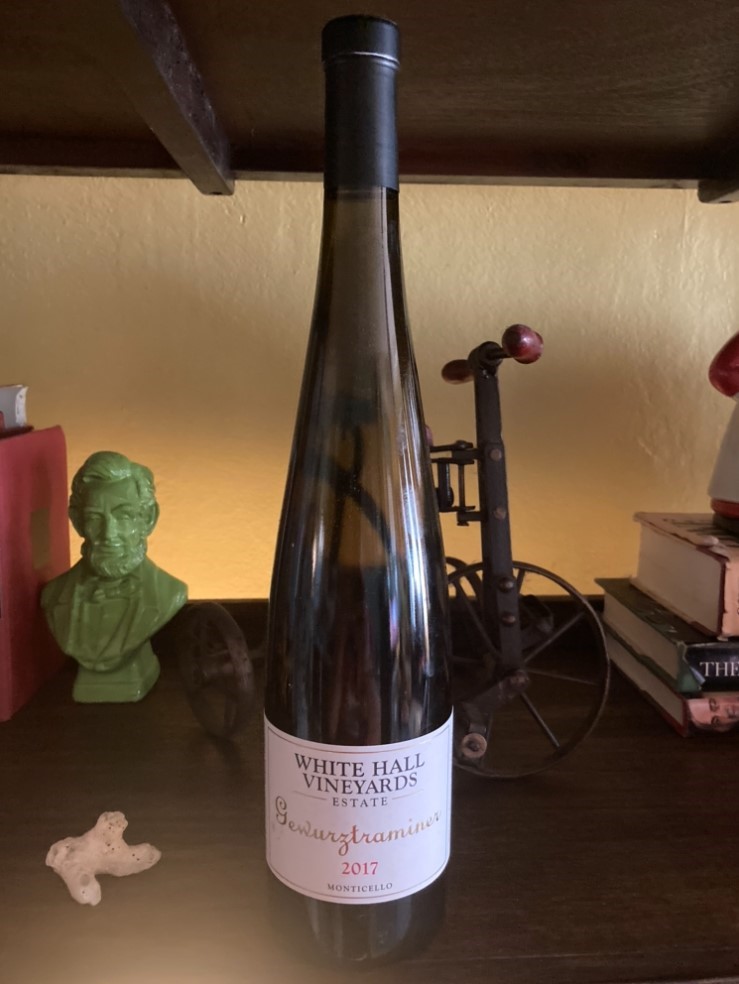
After the emotional charge of being so close to my American hero at his grave, I walked down the hill through the quiet, reflective woods and made my way to my heart’s desire – the gift shop. There’s tons of great stuff there from classic home furnishings to magnets to the aforementioned plant shop. But the real prize for me was the wine from nearby Monticello vineyards. I chose a bottle (several, actually) of White Hall Vineyards Gewürztraminer, a crisp white from the Alsace-Lorraine region of France that is very much like a Riesling. But better, in my opinion, and harder to find (which is why I grabbed a bunch). I also bought a lovely plant and several tchotchkes for my home to remind me of my magical trip through American history. You can also order Jefferson related merchandise through their online store.
Any American history buff will find Monticello a spiritual experience, as I did. It’s easy to forget I walk in his footsteps every day in the modern metropolis of Philadelphia, where he lived at the Graff House (7th and Market) while writing The Declaration of Independence. At Monticello, life is simplified. You can concentrate on Jefferson’s story with minimal distractions from the outside world – just as Jefferson lived his best life at his little castle atop the hill.
University of Virginia - The History
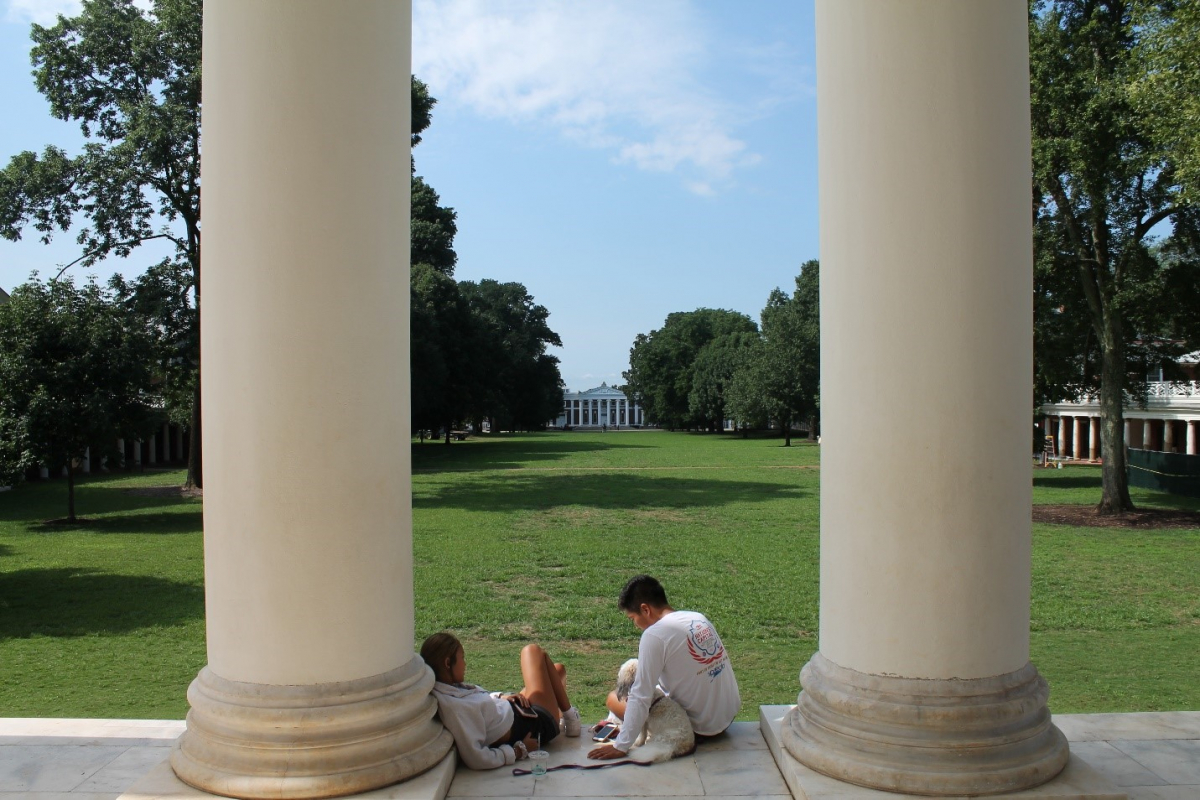
Thomas Jefferson is represented in three UNESCO World Heritage Sites: Independence Hall, Monticello and University of Virginia. Now that I’ve been to Charlottesville, I’ve touched all three. On my second day in this bucolic southern town, I walked 20 minutes down a Main Street that is anything but sleepy. Main Street connects downtown to the biggest attraction, University of Virginia’s Main Campus. If you don’t want to make the walk, there is a free trolley that runs along Main Street every 15 minutes during the day from downtown to UVA.
Founded in 1819 by Thomas Jefferson, the campus is home to approximately 25,000 students. The prestigious alumni include President Woodrow Wilson, Edgar Allan Poe, eight NASA astronauts, eight Pulitzer Prize winners, Katie Couric, Georgia O’Keefe, Tina Fey and 15 governors of Virginia.
Jefferson, James Madison and James Monroe (the current sitting President in 1819) were the original governing Board of Visitors. Jefferson and Monroe were also UVA’s first rectors.
The idea of UVA was born in Jefferson’s head while serving as President in 1802. He wrote to artist Charles Wilson Peale that his concept of the new university would be "on the most extensive and liberal scale that our circumstances would call for and our faculties meet," and it might even attract talented students from "other states to come, and drink of the cup of knowledge.” Although he was a proud William and Mary graduate from the same state he’d build his university, he’d grown wan with the idea of supporting that college because of their religious nature and making students recite a Catechism, all the while stifling the research of Jefferson’s favorite subject, the sciences.
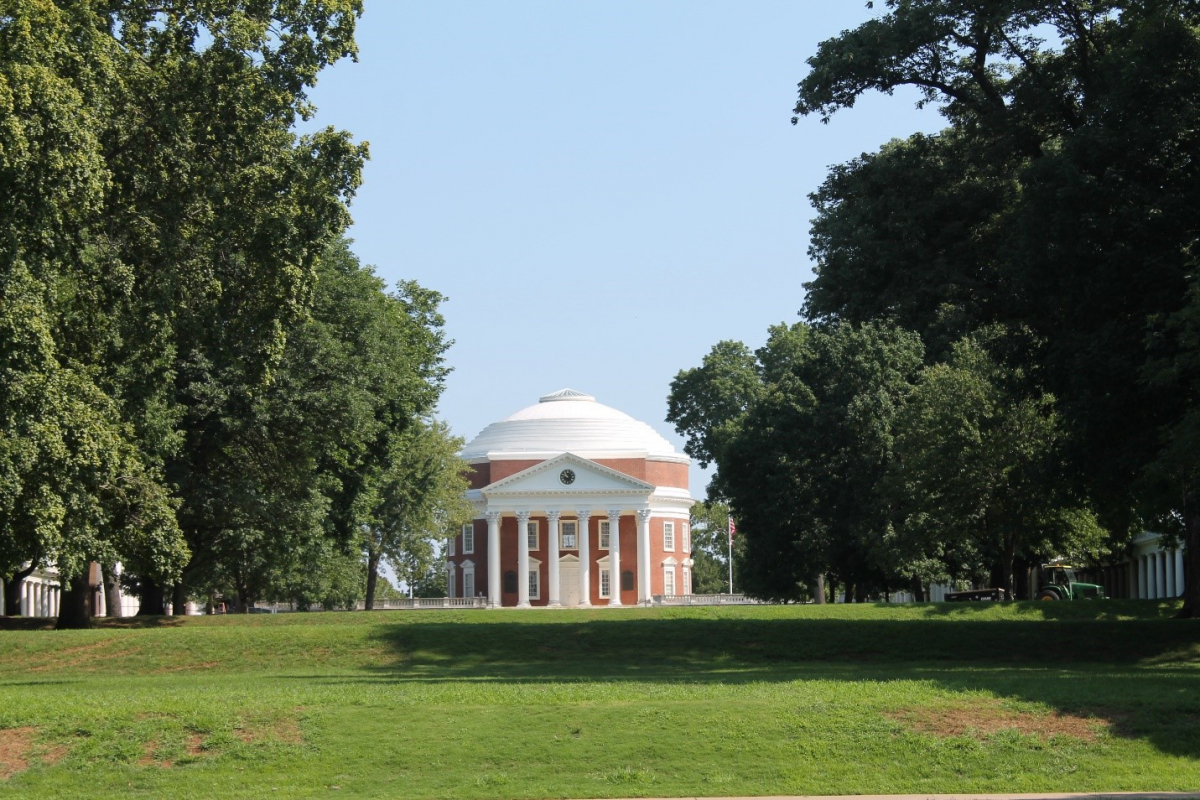
In 1817, Supreme Court Justice John Marshall, Monroe, Madison and Jefferson met in Virginia to discuss the location of UVA. They chose Charlottesville. Not really a surprise as Jefferson and Monroe lived there and Madison’s Montpelier was about 50 miles away. James Monroe purchased the farmland that would become UVA.
Jefferson was so intimately affixed to his darling University that he would host Sunday dinner parties every week for faculty, students and staff until his death in 1826. The school, which Jefferson dreamed would produce the American creams-of-the-crop, sort of got a bad reputation in its infancy of being open only to spoiled aristocrats. Petty quarrels often led to all out brawls. Jefferson even took to reprimanding the students during the school’s first year in 1825 but was too nervous and overcome with guilt to speak. He called the event “the most painful event” of his life.
Besides being classified among R1 Doctoral Activities (very high research activities), it’s got a proud sports heritage. The Cavaliers lead the Atlantic Coast Conference in men’s teams NCAA championships. They rank third in women’s and second in overall NCAA titles. In 2019, the Cavaliers won the NCAA championships in men’s basketball and lacrosse and joined several winning UVA teams including the College Cup, College World Series, and NCAA Tennis Championships.
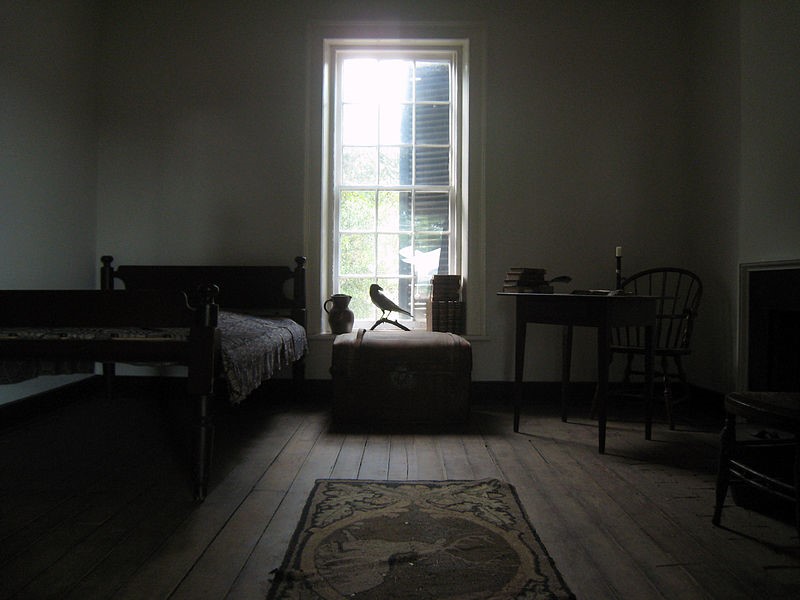
Edgar Allan Poe, who would eventually call Philadelphia home for several years, attended UVA for one semester but dropped out due to financial difficulties. The Raven Society, whose ethos is "to bring together the best men in the various departments of the university for mutual acquaintance and for cooperation in their efforts to protect the honor and dignity of the university," (source: "Constitution of the Raven Society of the University of Virginia"), still maintains their meeting space in 13 West Range, Poe’s original dorm.
The Architecture
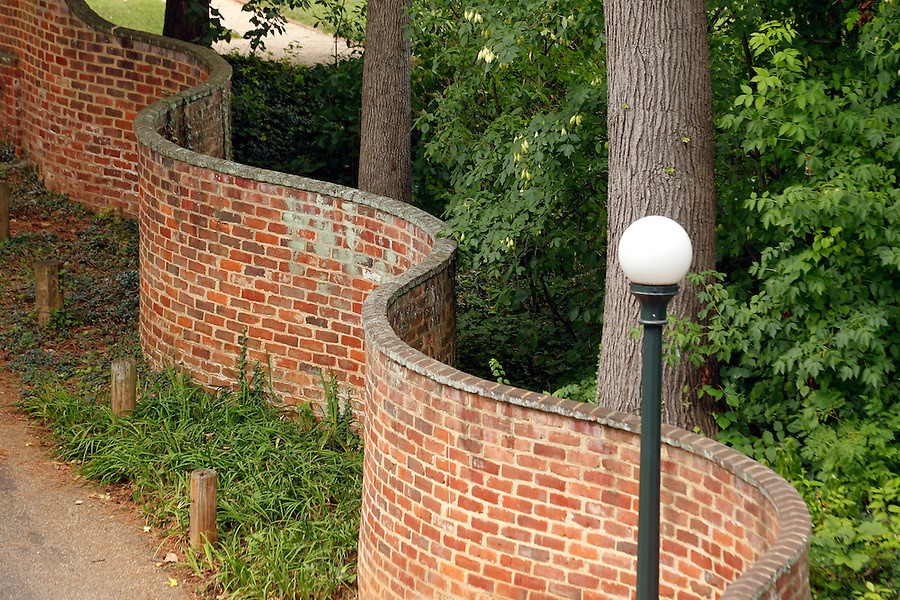
Jeffersonian architecture is the hallmark of UVA. In 1895, the New York Times deemed the architecture at UVA as “incomparably the most ambitious and monumental architectural project that had or has yet been conceived in this century.” (source: “Architectural Record,"January–March 1895, pages 351–353). In its Bicentennial issue, the American Institute of Architects called it "the proudest achievement of American architecture in the past 200 years." (source: AIA Journal, 65, July 1976, page 91).
One of the trademarks of UVA are the slithering “serpentine walls.” Jefferson invented this feature, making the wavy walls stronger with less bricks – only one brick thick. Not only are they practical, they’re an extremely effective aesthetic feature of the beautiful campus.
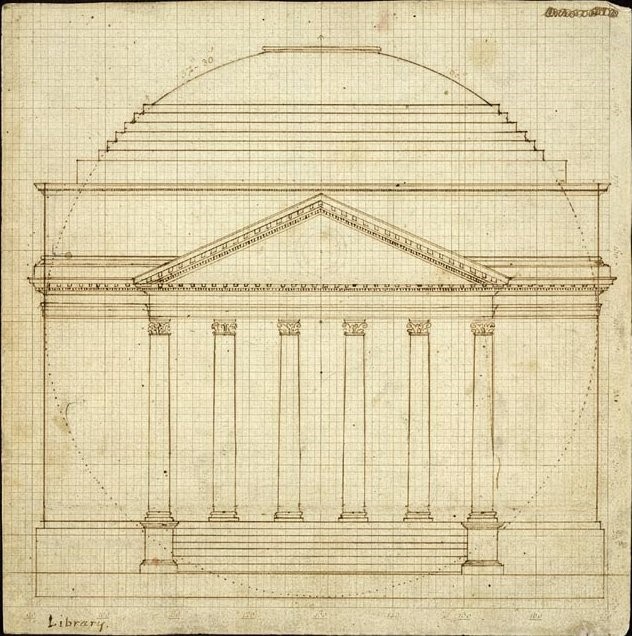
Probably the most famous piece of architecture and one of the most recognized campus buildings in the USA is the Rotunda. Standing at the north side of the lawn, it is half the width and length of the building that inspired it, the Pantheon in Rome. The Rotunda was the first library on campus and the University was built around it. If that sounds like a Jeffersonian plan to you, it is. He wanted the campus to orbit an Eden of books, not a religious building or chapel. It was a message to all students that they were here to learn, not pray. The Rotunda, Jefferson stated, represented the "authority of nature and power of reason"
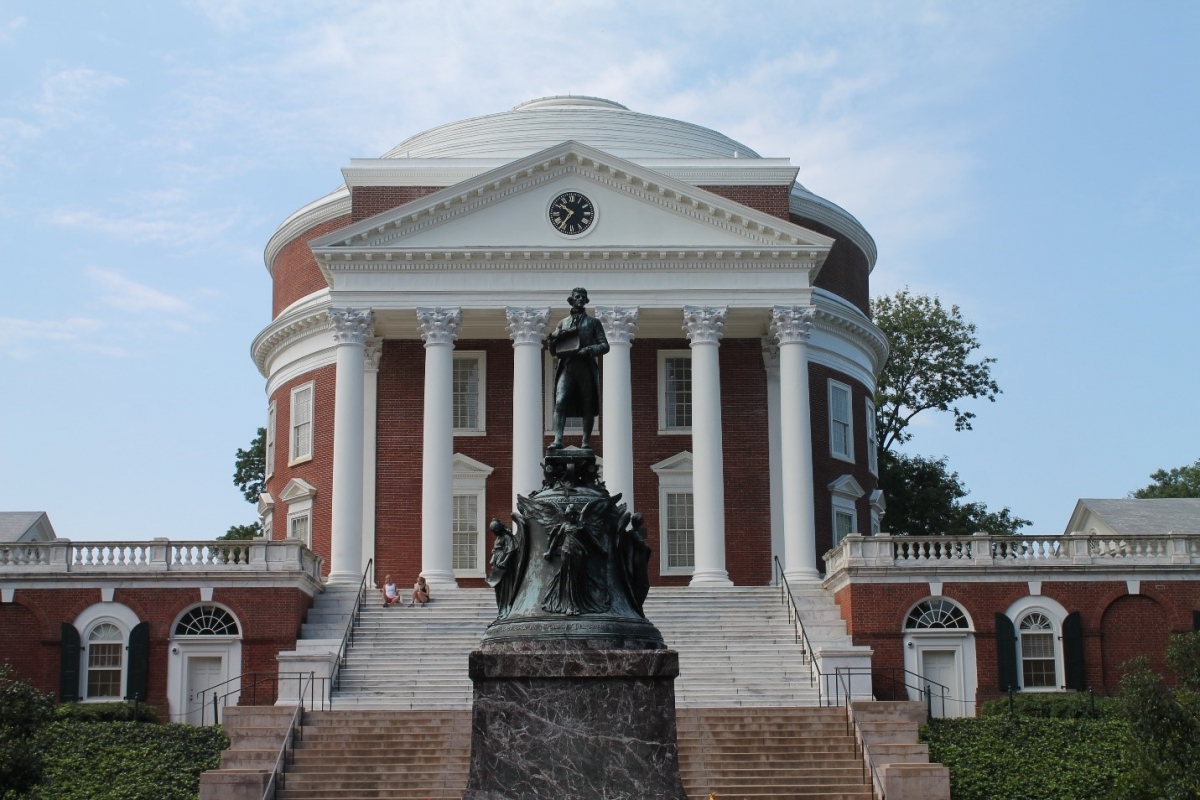
Does the Rotunda look familiar to you Jefferson aficionados? You may notice that there is a dome on top of the building, just like at Monticello and the Jefferson Memorial in Washington, DC. The Rotunda is another example of Palladian architecture, with Jeffersonian touches like white trim, red brick and a circular or octagonal shape. It’s a masterpiece of 19th Century American architecture for sure!
When the Marquis De Lafayette made his grand tour of the USA from 1824-1825, he dined with Jefferson under the dome of the yet unfinished Rotunda at the Inaugural Banquet and toasted the founder as the “Father of the University of Virginia.” This soubriquet attracted Jefferson, and the term is on his grave. The Marquis De Lafayette, during the same grand tour, also coined the term “Independence Hall” when he visited the fabled Pennsylvania State House in Philadelphia in 1824.
Spilling south from the University are the Lawn and Range Dorms, the University’s original student housing. Little has changed since the 1800’s in these dorms (not even air conditioning). It is considered a prestigious honor to be one of the 54 fourth year undergraduates selected to occupy these dorms. The Lawn has been designated a National Historic Landmark.
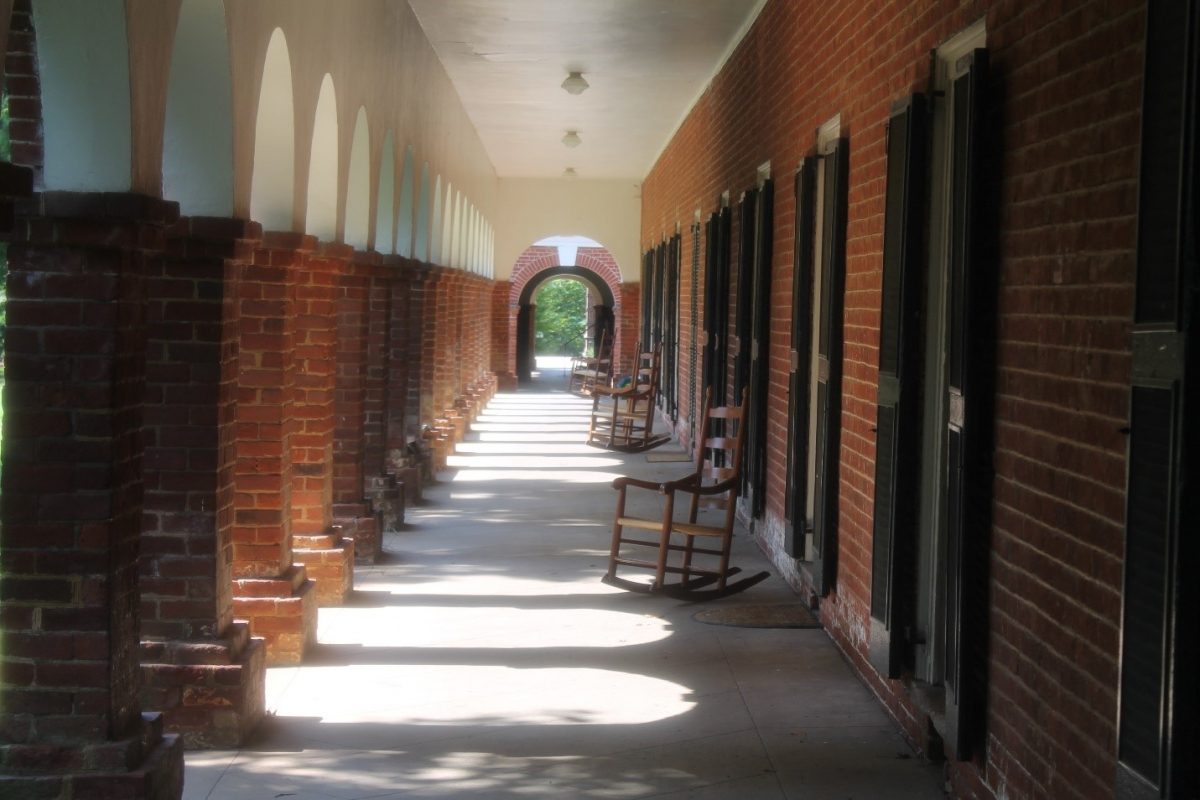
“What we wish is that these pavilions, as they will show themselves above the dormitories, shall be models of taste and good architecture, and of a variety of appearance, no two alike, so as to serve as specimens for the architectural lecturer. Will you set your imagination to work, and sketch some designs for us, no matter how loosely with the pen, without the trouble of referring to scale or rule, for we want nothing but the outline of the architecture, as the internal must be arranged according to local convenience? A few sketches, such as may not take you a minute, will greatly oblige us.”
— Thomas Jefferson, Letter to William Thornton, 1817
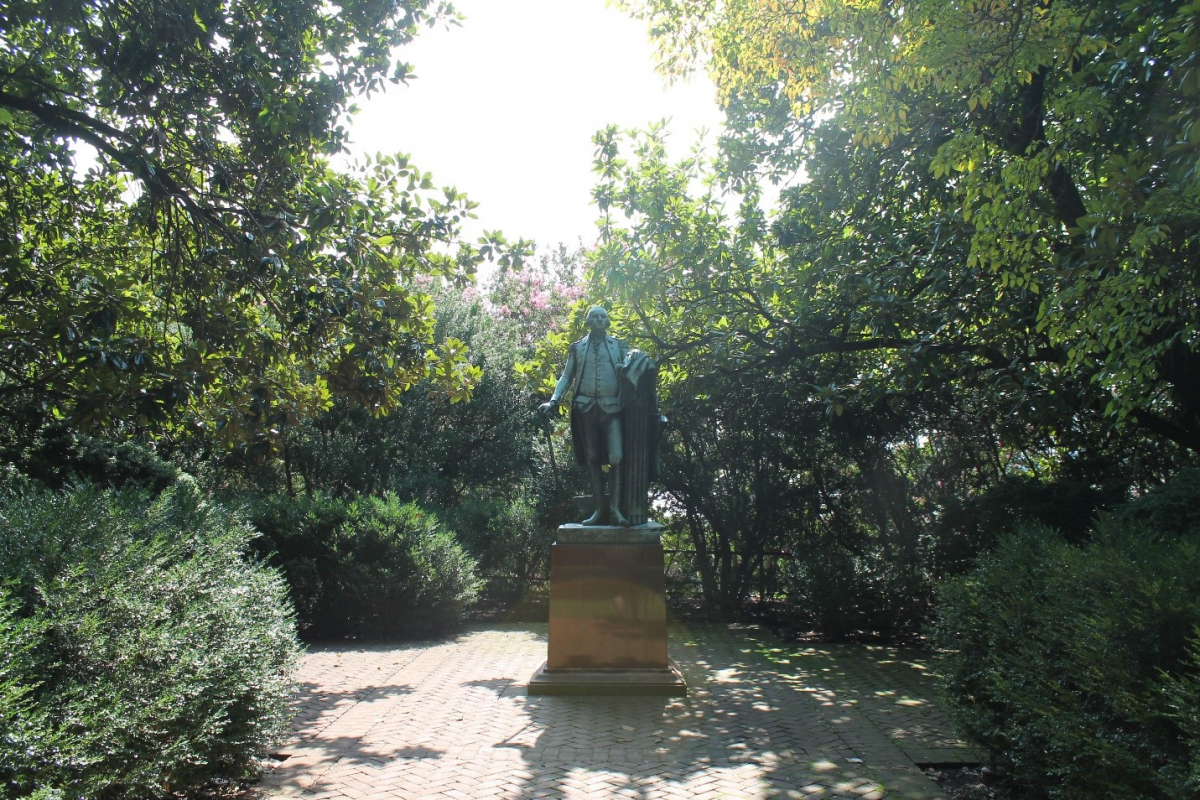
Nestled in gardens between the dorms you’ll find some beautiful statues, including one of George Washington and one of Jefferson. There are all sorts of beautiful surprises in each nook and around each corner on UVA’s campus.
Slavery at UVA
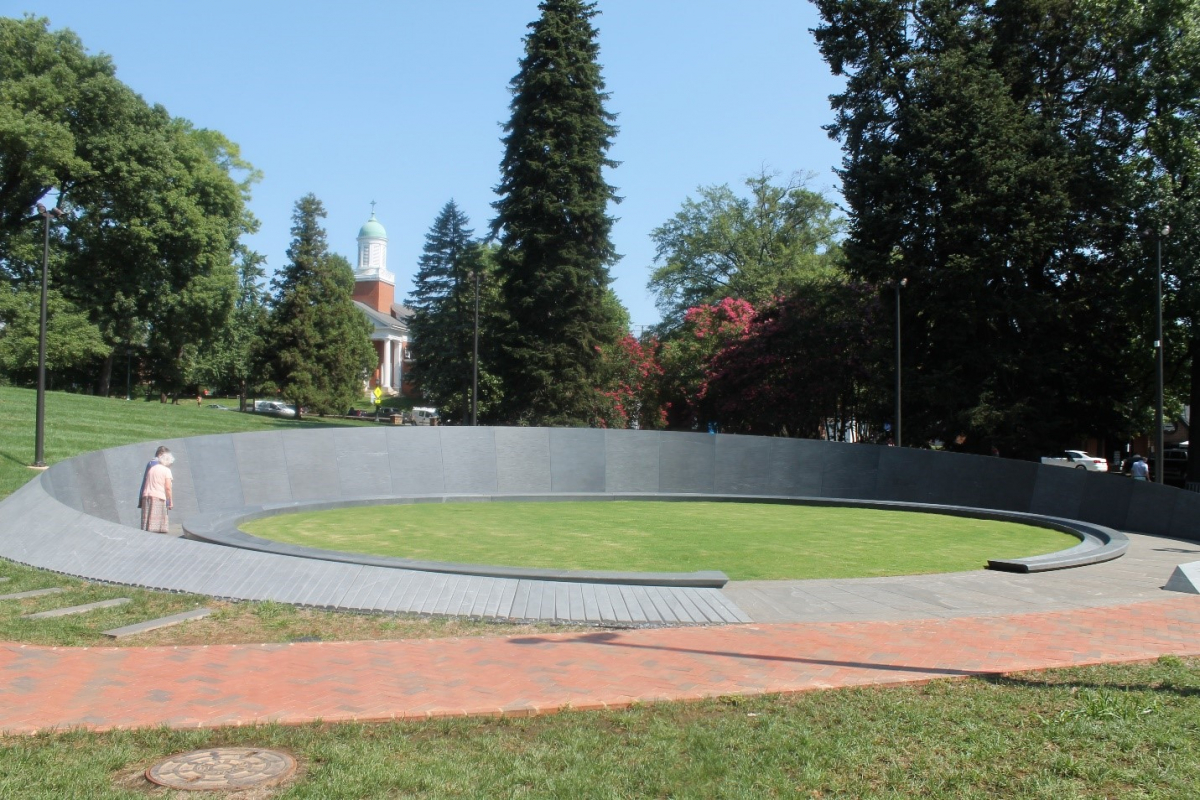
"The Memorial is oriented tangent to two paths. The first path leads from the Memorial in the direction of the North Star, which for the enslaved led to freedom. The second path aligns with the sunset on March 3rd, which commemorates the day that Union troops emancipated the local enslaved community at the close of the Civil War. The communities of Charlottesville and the University will observe this important event through the newly instituted Liberation and Freedom Day March through the city. Also sharing the same north/west orientation is the Memorial’s grove of gingko trees that harkens back to the area’s previous use as a productive landscape of fruits and vegetables tended to by enslaved laborers."
I didn’t really want to follow a map of the campus, although they were readily available in my hotel lobby. I chose instead to wing it and ask students or faculty how to get around. I knew there was an awesome new slavery memorial, but nobody I asked really knew where it was. I eventually found it to the east of the Rotunda right off Main Street.
It reminded me of the Vietnam Memorial in DC. It starts off small, nearly in the ground, but grows up to several feet high as the names of slaves grows thicker. The rock is appropriately called “Virginia Mist” granite and is locally sourced. It’s in a broken circle, almost like a collar that a slave would be forced to wear around their necks. It is 80 feet in diameter, just like the dome of the Rotunda. Inside the ring is a concentric ring with a timeline of the history of UVA pertaining to Thomas Jefferson and slavery.
The outer ring consists of the names of 4,000 or more enslaved men and women known to have built the University. As of 2020, there are only 578 actual names listed. Another 311 are mysteriously known only by first names, jobs, or relations to others who worked there. Of the others whose names and stories are lost to history, a harsh slash represents that yes, there was a person, yes, they were enslaved and yes they built this university on their backs. But who were they? Only God can tell us. The slash, I’ve been told by a student, is actually representative of a whip.
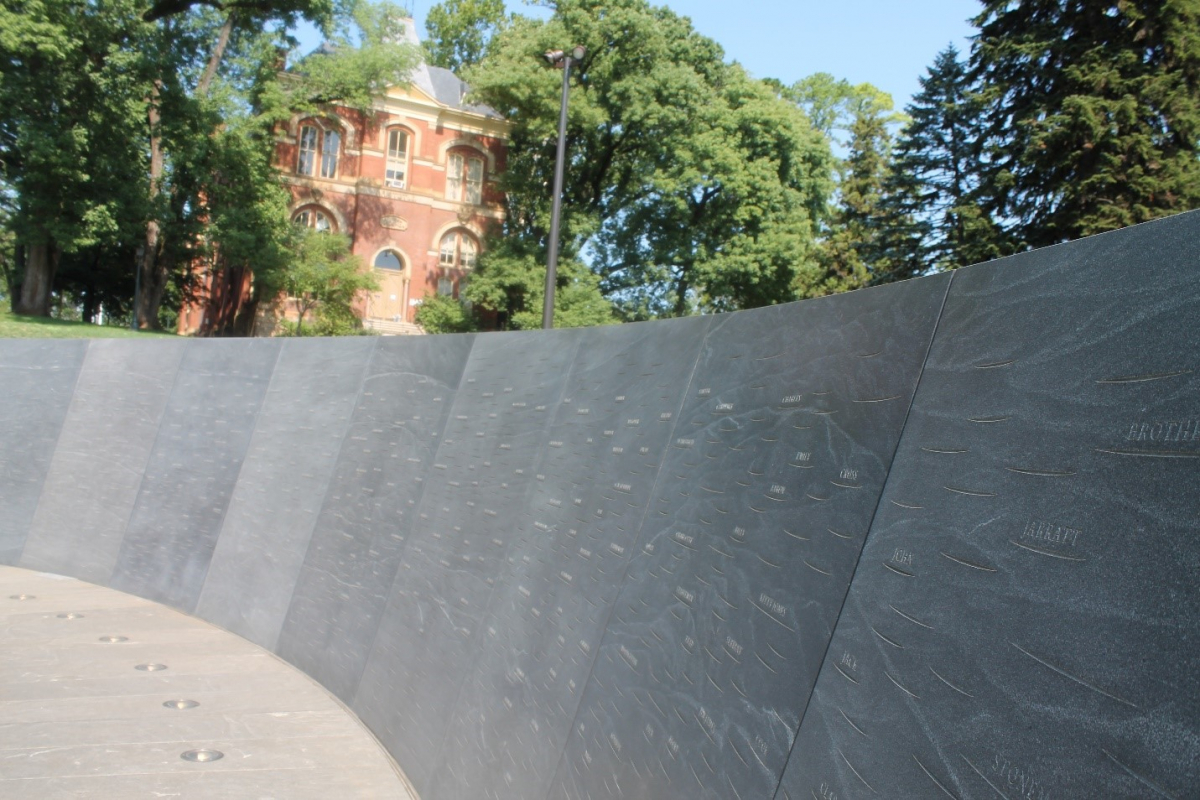
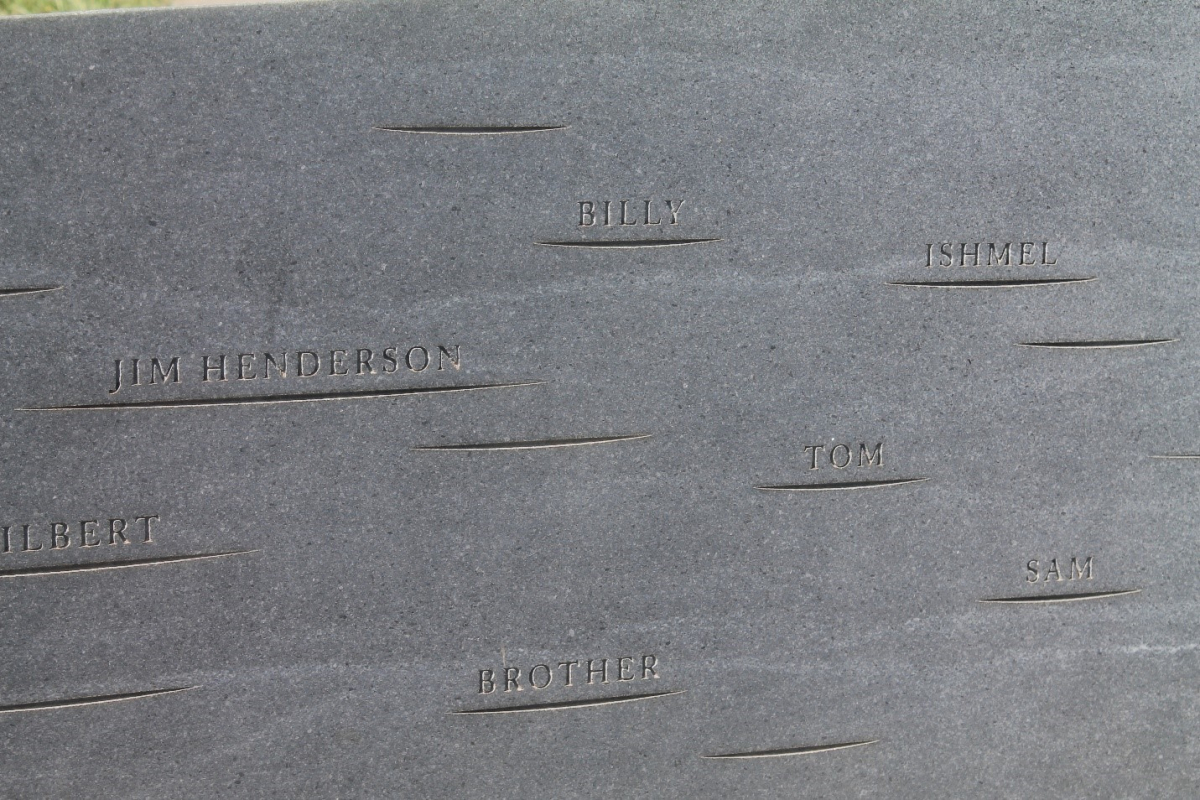
There’s more on the exterior. You’ll see a subtle set of sunken eyes. These eyes are derived from an image of Isabella Gibbons, an enslaved woman owned by UVA professors before the Civil War. After the war, she educated free African Americans. Her spirited words are engraved on the wall:
“Can we forget the crack of the whip, cowhide, whipping-post, the auction-block, the hand-cuffs, the [manacles], the iron collar, the negro-trader tearing the young child from its mother’s breast as a whelp from the lioness? Have we forgotten that by those horrible cruelties, hundreds of our race have been killed? No, we have not, nor ever will.”
While I find it impressive that UVA has been making strides in penance with its original sin, the fact that it only opened in 2019 is a little shocking considering how it was built by slave labor 200 years ago. Still, it’s there – better late than never, and it will move you.
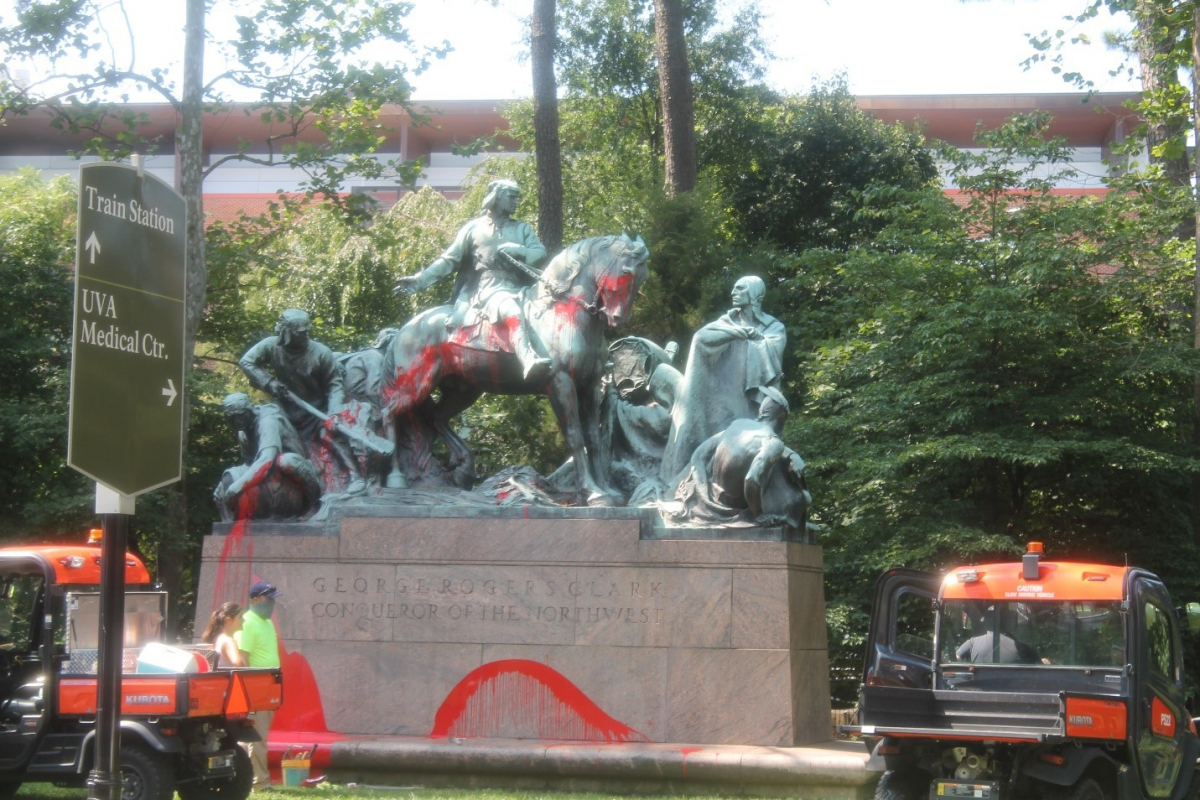
While leaving UVA and walking back to the hotel, I was shocked to see the American political climate in action. A statue of George Rogers Clark had been just vandalized on the campus and workers just started cleaning it up. I immediately looked him up and found out that he’d been called “The Conqueror of the Northwest.” His extensive knowledge of the Pacific Northwest helped out his brother, William, who surveyed the continent with Meriweather Lewis. While he did own two slaves in his lifetime, I found scant information about him outside of his accolades. The statue does show him towering over subversive indigenous people. It’s a troublesome representation for sure. I thought about what a strange time we live in, with political unrest and a pandemic. And what a strange time to be travelling. What a strange time to be alive.
Conclusion
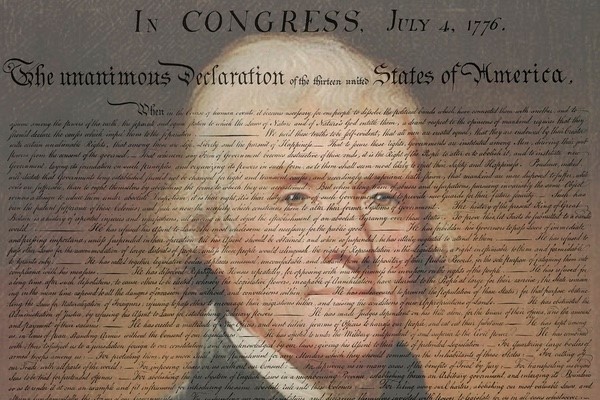
I have always found Thomas Jefferson to be an elusive, enigmatic character. His dichotomy of personalities have always perplexed me. I’ve read everything I could about the man, trying to figure him out. How did the man who helped create a government for the people and by the people independent of British rule stay so humble? Why did a man who eschewed monarchy choose to build a mansion on a mountain like a king? Why did he walk away from the Presidency without giving himself any credit? Is true love possible between a master and a slave? Was his relationship with Sally Hemings consensual? How many children exactly did Jefferson father? How did the man who wrote that all men are free own over 600 human lives?
None of these questions have been answered, and I fear they never will be answered as the man’s been silent for centuries. I have visited his plantation, paused at his statue on the Seine in Paris, and walked in his footsteps in the Constitutional Walking Tour of Philadelphia, and I feel like I know less about him than I ever did. Every new door that opens on illuminating this man just makes a window slam shut. I can’t figure him out, I never will. He’s an American sphinx. He has a story to tell, but he never reveals his secrets. I hope he never will.
And that’s Thomas Jefferson.
“God was not in the details for Jefferson; he was in the sky and stars.”
-- Joseph J. Ellis (source: American Sphinx: The Character of Thomas Jefferson, Joseph J. Ellis, 1998)
Join me as I travel to the home of George Washington at Mt. Vernon in my next blog...



